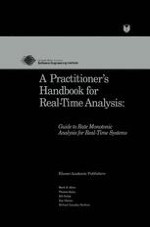A Practitioner's Handbook for Real-Time Analysis: Guide to Rate Monotonic Analysis for Real-Time Systems contains an invaluable collection of quantitative methods that enable real-time system developers to understand, analyze, and predict the timing behavior of many real-time systems. The methods are practical and theoretically sound, and can be used to assess design tradeoffs and to troubleshoot system timing behavior. This collection of methods is called rate monotonic analysis (RMA).
The Handbook includes a framework for describing and categorizing the timing aspects of real-time systems, step-by-step techniques for performing timing analysis, numerous examples of real-time situations to which the techniques can be applied, and two case studies.
A Practitioner's Handbook for Real-Time Analysis: Guide to Rate Monotonic Analysis for Real-Time Systems has been created to serve as a definitive source of information and a guide for developers as they analyze and design real-time systems using RMA. The Handbook is an excellent reference, and may be used as the text for advanced courses on the subject.
